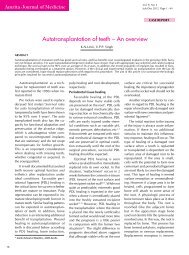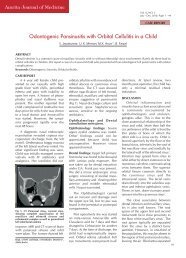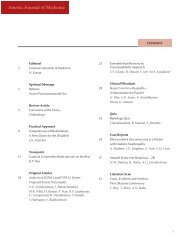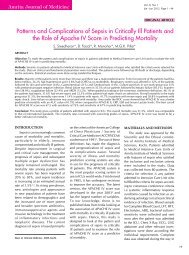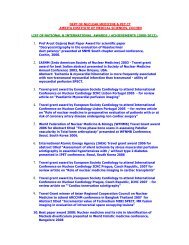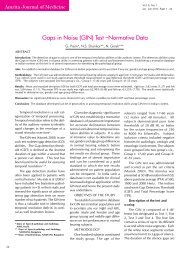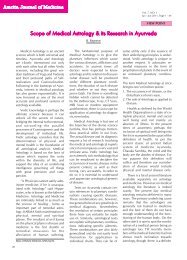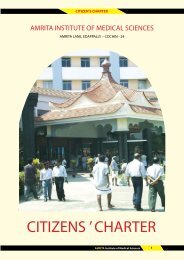Journal of Medicine Vol 2 - Amrita Institute of Medical Sciences and ...
Journal of Medicine Vol 2 - Amrita Institute of Medical Sciences and ...
Journal of Medicine Vol 2 - Amrita Institute of Medical Sciences and ...
Create successful ePaper yourself
Turn your PDF publications into a flip-book with our unique Google optimized e-Paper software.
<strong>Amrita</strong> <strong>Journal</strong> <strong>of</strong> <strong>Medicine</strong><br />
Statistics in Evidence Based <strong>Medicine</strong><br />
Example –2: Results <strong>of</strong> a clinical trial comparing the effect <strong>of</strong> the st<strong>and</strong>ard drug <strong>and</strong> a new drug in improving the<br />
condition <strong>of</strong> the disease are given below:—<br />
DRUG - OUTCOME<br />
Improved Not improved Total<br />
A (St<strong>and</strong>ard) 20 30 50<br />
B (New) 35 15 50<br />
Total 55 45 100<br />
While interpreting NNT due consideration should be<br />
given to the other factors such as age, severity, duration<br />
<strong>and</strong> other epidemiological factors. Also, when different<br />
NNTs are to be compared with respect to different treatments,<br />
proper care should be taken to see whether the<br />
groups are comparable otherwise. NNT should be calculated<br />
when there is a comparator (placebo, no treatment<br />
or any other treatment), which is followed, in any st<strong>and</strong>ard<br />
experimental study. NNT gives more information<br />
than the Relative risk because it takes into consideration<br />
the baseline frequency <strong>of</strong> the outcome (with respect to<br />
the comparative group). It is a summary measure which<br />
can be easily understood <strong>and</strong> interpreted even by a nonmathematical<br />
/ statistical person. Comparison <strong>of</strong> NNT<br />
values for different treatments may help the clinicians in<br />
decision-making process. NNTs are very widely <strong>and</strong> increasingly<br />
used in many clinical trials <strong>and</strong> epidemiological<br />
experimental studies.<br />
Example-3: The following data gives the results <strong>of</strong> a<br />
study where continuous planned health education was<br />
given to 50 smokers for three months for stopping the<br />
smoking habit <strong>and</strong> another 50 smokers were not given<br />
any health education.<br />
SMOKING<br />
Health Stopped Not- Total<br />
education<br />
stopped<br />
Yes 30 20 50<br />
No 10 40 50<br />
Total 40 60 100<br />
REFERENCES<br />
1. Cook RJ, Sackett DL. The number needed to treat: a clinically<br />
useful measure <strong>of</strong> treatment effect. British <strong>Medical</strong> <strong>Journal</strong><br />
1995;310:452-4.<br />
2. Altman DG. Confidence intervals for the number needed to<br />
treat. BMJ 1998; 317:1309-12.<br />
3. Sackett DL, Deeks JJ, Altman DG. Down with odds ratios!<br />
Evidence Based <strong>Medicine</strong>, 1996,1:164.<br />
4. Davies HT. Interpreting measures <strong>of</strong> treatment effect. Hosp Med<br />
1998;59(6) 479-501.<br />
5. Moriarty PM. Relative ris kreduction versus number needed to<br />
treat as measures <strong>of</strong> lipid lowering trial results. Am J Cardiol<br />
1998;82(4)505-7.<br />
6. Rembold CM. Number needed to screen-development <strong>of</strong> a statistic<br />
for disease screening. BMJ 1998;317(7154)307-12.<br />
7. Vickers AJ, Tijssen JG, Kleijnen J, et al. Number needed to treat<br />
<strong>and</strong> placebo controlled trials. Lancet 1998;351(9099)310.<br />
8. Thomas R, Padma P, Braganza A, et al. Indian J Ophthalmol<br />
1996,44(2)113-5.<br />
9. Rajkumar SV, Sampathkumar P, Gustafson AB. Number needed<br />
to treat is a simple measure <strong>of</strong> treatment efficacy for clinicians.<br />
J Gen Intern Med 1996;11(6)357-9.<br />
10. Wiffen PJ, Moore RA. Demonstrating effectiveness – the concept<br />
<strong>of</strong> numbers needed to treat. J Clin Pharm Ther<br />
1996;21(1)23-7.<br />
20



